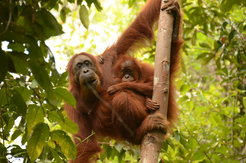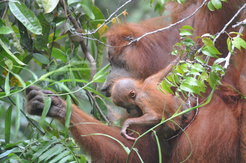Not all orangutan mothers raise their infants the same way
Sumatran orangutan mothers differ from one another in how they behave with and take care of their infants

- Mothering styles: Sumatran orangutan mothers differ from one another in how they behave with and take care of their infants and how flexibly they adjust their mothering behaviors as their infants grow.
- One mother, one way: Whilst mothers differed from one another in their maternal behaviors, they remained consistent in their behaviors with their different infants.
- Unknown impact on offspring: Consistent differences among Sumatran orangutan mothers suggest that individual maternal personalities may exist, potentially influencing infant development.
A new study of wild Sumatran orangutans by researchers at the Max Planck Institute of Animal Behavior (MPI-AB) has found that mothers consistently differ in their maternal behaviors toward their infants, even after controlling for biological, social, and environmental factors. Mothers also consistently vary from one another in how flexibly they adjust their parenting as their infants grow. For this study, the researchers analysed data on six maternal behaviors collected over 15 years.
“Our study shows that Sumatran orangutan mothers are not all the same when it comes to parenting behaviors,” said Revathe Thillaikumar, a postdoctoral researcher at MPI-AB and first author of the study. “For example, we found that during the developmental period, some mothers consistently carried their infants more than others, while some terminated body contact more frequently than others. What was especially interesting is that these differences stayed consistent across the different infants of a mother, even when we accounted for factors known to affect maternal behavior.”
Because Sumatran orangutans have the longest known infant dependency of any nonhuman animal, the researchers also examined how maternal behavior changes as infants develop. “We found that mothers made flexible adjustments to their parenting behaviors and that they consistently differed from one another in how they made these adjustments. For example, while all mothers tended to terminate spatial proximity more frequently as their infants grew older, some mothers consistently did so more than others across all their offspring,” added Revathe.

The study examined six behaviors of wild Sumatran orangutan mothers towards their infants: body contact, staying close, carrying, and feeding nearby. These maternal behaviors are important because they influence how infants are able to learn skills directly from their mothers and how safely they can navigate dense canopies in a tropical rainforest. Data were collected at the Suaq Balimbing research site in Indonesia on 22 mother-infant pairs from over 6000 observational hours. The researchers found consistent differences in many of the studied maternal behaviors.
Caroline Schuppli, a group leader at MPI-AB and senior author of the study says: “The consistent differences among mothers—both in the extent of their behaviors and in how these behaviors changed over the course of infant development—suggest that orangutans may possess individual maternal personalities.”
Regarding the broader implications of their findings, Schuppli added: “We do not yet know whether differences in maternal behaviors bring about differences in aspects of infant development. Due to the many years that orangutans take to develop, we need at least a decade more to accumulate the data needed to investigate the effect of these differences on infant development.”
This study was made possible by the ongoing collaborative research efforts of researchers at the MPI AB and Universitas Nasional Jakarta (UNAS), as well as local research assistants and Indonesian authorities.













